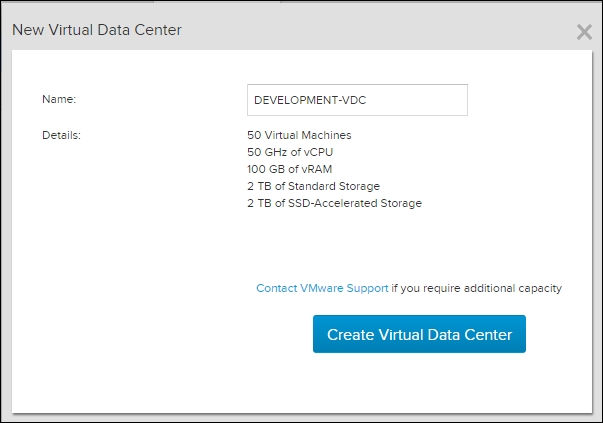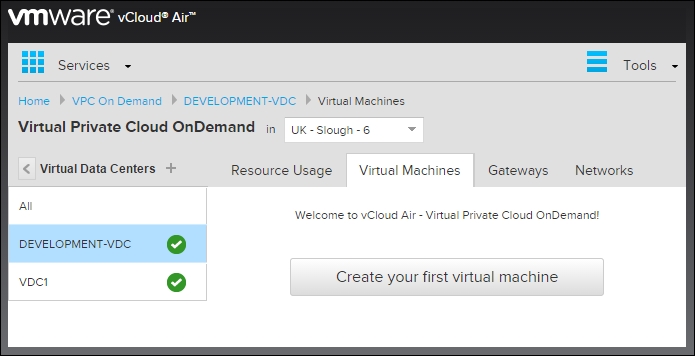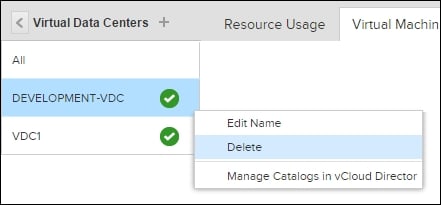VDCs are a mechanism by which users can isolate particular applications, and application groups by providing them dedicated compute, storage, and network resources that are logically carved up from underlying physical resources. For example, an organization typically has internal departments, such as development, testing, production, and HR. vCloud Air can create VDCs for each of these departments in such a way that the cloud administrator can create and track resource utilization for each department, and bill them based on their resource consumptions.
Using vCloud Air, you can perform a lot of management activities on a VDC, such as create VDCs, assign the maximum number of virtual machines that each VDC can support, assign dedicated routed and internal networks and storage, and so on.
Let's run through a quick example to see how easily we can create a VDC using the vCloud Air interface.
On the main dashboard, select the pop-out arrow near the Virtual Data Centers option. You should see a default VDC is already created for you named VDC1. You can create and list multiple VDCs using this this console itself.
The following screenshot shows the VDC created by default under the Virtual Machines tab:

To create your own VDC, click on the + sign next to the Virtual Data Centers option. This will display the following popup window. Provide a suitable name for your new VDC and click on Create Virtual Data Center when done.
The following screenshot shows the New Virtual Data Center page:

As you can see from the preceding screenshot, the VDC is created with a predefined set of resources allocated to it, such as 50 GHz of CPU, 100 GB of vRAM, and so on. You can contact the VMware support team if you wish to add more resources to your VDC.
Once created, you can list your VDCs as we did in the earlier steps. An important point to remember here is always remember to select your VDCs first, and then create virtual machines, or perform any changes to your environment.
Virtual machines created now will be specific to the VDCs, but if you wish to list all the VMs from your environment, then simply select the All option under the Virtual Data Centers drop-down list.
Note
Each VDC that you create will have its own default routed-gateway and isolated network created as well, so make sure you are editing or deleting the correct networks from the correct VDC.
The following screenshot shows the VDC that you just created:

Deleting a VDC is also a simple process. Simply right-click on the VDC's name and select the option to delete.
Note
Deleting a VDC will free up all the resources currently allocated to it including gateways, networks and virtual machines.

Deleting a VDC
VMware vCloud Air provides a simple Identity Access Management (IAM) portal. By using it you can create users, and assign them individual roles.
There are five specialized sets of roles provided by vCloud Air; they are summarized as follows:
Virtual infrastructure administrator: they are a kind of super administrator. They have the privileges to add and modify VDCs and virtual machines. They can also view gateways, networks, activity logs, and list other users.
Account administrator: they can only add users and reset passwords. Account administrators can view VDCs and their contents as well.
Network administrator: this is a special role that is designed to only create and manage the networking infrastructure of your VDC, which includes routed-gateways, isolated networks, and so on. Network administrators can also view virtual data centers, virtual machines, activity logs, and users.
Subscription administrator: they can manage user accounts in My VMware, and have permission to file support requests.
Read-only administrator: they can view VDCs, virtual machines, and networks, and can list other users, but cannot alter settings in the administration areas.
Now that we understand the specific administrative roles provided by vCloud Air, let's quickly add a new user to our infrastructure.
On the main dashboard, select the Tools tab and under it, select the Users option, as shown:

Click on the Add User option. This will pop up the following screen on which you can create your user and assign him the required roles that we discussed previously. Provide the first and last name, and also a valid email address for your user. Once done, simply select the Add User option.

Once the user is provisioned, you can choose to enable or disable it; reset the user's password, and then even delete the user using the same console, as shown:




